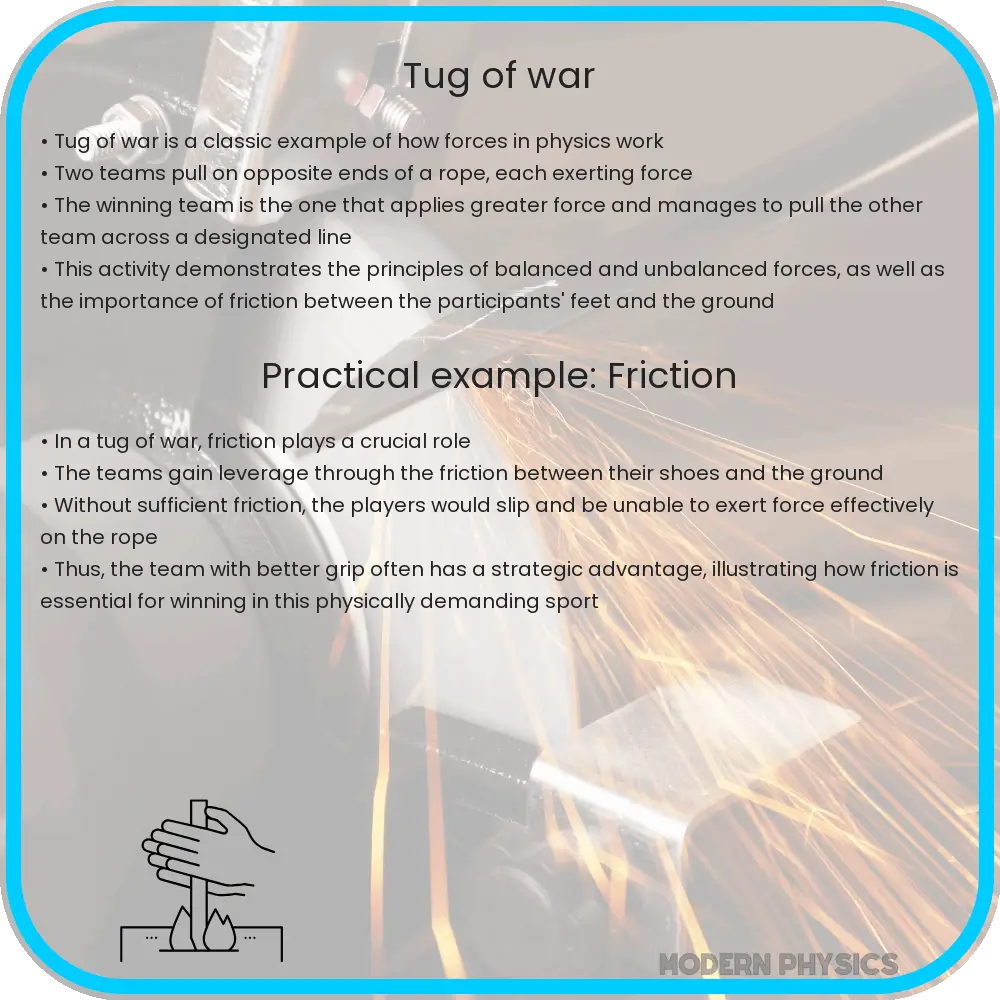Explore key strategies, mechanics, and equilibrium techniques in tug of war, blending physics, teamwork, and training for optimal performance.

Tug of War: Unveiling the Strategies and Mechanics
Tug of war, a timeless team sport, is not just about raw strength; it intricately combines strategy, physics, and team coordination. Understanding the underlying mechanics and equilibrium techniques can significantly enhance a team’s performance.
Strategic Positioning
Success in tug of war begins with strategic positioning. Teams should align in an order that maximizes collective strength and balance. Generally, the strongest members are positioned at the back, acting as the anchor, while the front positions are filled by players with good grip strength and agility. This arrangement ensures a steady pull and effective transmission of force along the rope.
Equilibrium and Force Distribution
Equilibrium in tug of war is a delicate balance between opposing forces. According to Newton’s Third Law, for every action, there is an equal and opposite reaction. This principle is evident as each team exerts force on the rope, creating tension. Effective teams distribute this force evenly across all members, maintaining a stable center of gravity.
Grip Techniques
The way team members hold the rope plays a crucial role. A common technique is the ‘underhand grip,’ where the palm faces up, allowing for a stronger and more enduring hold. Wrapping the rope slightly around the hand can increase grip but requires careful attention to prevent injuries.
Stance and Movement
Stance is critical. Players should position their feet firmly and wide apart, with one foot slightly ahead of the other for stability. The key to movement is synchronicity; team members should lean back and move their feet simultaneously, creating a rhythmic and unified pull. This coordination maximizes the force exerted while conserving energy.
Communication and Teamwork
Communication is essential. Team members must be attuned to each other’s movements and the captain’s commands. A synchronized pull is more effective than individual efforts, no matter how strong. Teams that communicate and move as a single unit can outperform physically stronger opponents.
Understanding the mechanics and strategies of tug of war can transform a group of individuals into a cohesive and formidable team. The blend of physical strength, strategic positioning, and team dynamics makes this sport a complex yet fascinating study in teamwork and physics.
Mastering the Mechanics: Leverage and Timing
Central to tug of war is the concept of leverage. The leverage principle states that the further away from the pivot (or fulcrum) a force is applied, the greater its impact. In tug of war, this translates to the importance of each team member maximizing their distance from the rope’s center point. The larger the distance, the more force they can exert on the rope, enhancing their team’s pulling power.
Understanding the Role of Friction
Friction plays a pivotal role in tug of war. The friction between the players’ feet and the ground provides the necessary resistance to pull effectively. Teams often choose footwear and positions to maximize this friction. Additionally, the texture and material of the rope can affect grip and friction, influencing the force transmission along its length.
Psychological Factors
Beyond physical strategies, psychological factors also influence tug of war. Morale and confidence can significantly impact performance. A team that maintains high spirits and a positive attitude is often more cohesive and resilient under pressure.
Techniques for Maintaining Equilibrium
Maintaining equilibrium is vital. Teams must avoid sudden jerks or uncoordinated movements, which can lead to loss of balance and reduced force application. Continuous, steady pressure with synchronized movements helps maintain equilibrium and maximizes the force applied to the rope.
Training and Conditioning
Effective tug of war teams invest in specific training and conditioning. This includes exercises to enhance grip strength, core stability, and overall endurance. Regular practice in coordinating movements and adapting to different scenarios is also essential for developing a well-rounded team.
Conclusion
Tug of war, often perceived as a simple test of strength, is in reality a complex interplay of physics, strategy, and teamwork. Success in this sport hinges not just on physical prowess but also on understanding the mechanics of leverage, friction, and equilibrium. Strategic positioning, effective communication, and psychological resilience further amplify a team’s capabilities. By mastering these elements, a tug of war team can transform their collective effort into a formidable force, epitomizing the essence of synergy and cooperative strength.
